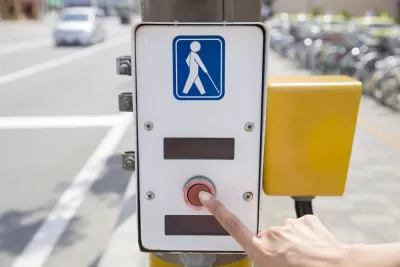Near-silent electric vehicles pose a danger to people with visual impairments, so engineers are studying ways to make the vehicles audible while maintaining the benefits of quieter streets.

“The electrification of mobility presents humanity with a rare opportunity to reimagine the way cities might sound,” writes John Seabrook in the New Yorker, replacing the grating noise of gas engines with the quiet smoothness of electric vehicles. But car noise can also be an important warning mechanism for people with visual impairment and all pedestrians. “Not only does engine noise announce a vehicle’s presence; it can also convey its direction, its speed, and whether it is accelerating or decelerating.”
According to a little-known 2010 Congressional act, “every E.V. and hybrid manufactured since 2020 and sold in the U.S. must come equipped with a pedestrian-warning system, also known as an acoustic vehicle alerting system (AVAS), which emits noises from external speakers when the car is travelling below eighteen and a half miles per hour.”
The article outlines the development of electric car soundscapes, which have become more specialized as research reveals the most effective sounds for both pedestrians and drivers. “Automakers have enlisted musicians and composers to assist in crafting pleasing and proprietary alert systems, as well as in-cabin chimes and tones.” The question is more complicated than one might imagine: “How do you put into regulatory legal language that a car should sound like a car?” asks John Paré of the National Federation of the Blind.
Meanwhile, electric cars must still be loud and distinctive enough to be useful. To that end, we could end up with a future just as noisy as today, “a cacophony of sound and dissonance if these cars are all singing different tunes, in different key signatures and pitches,” says Douglas Moore, a senior expert in exterior noise at General Motors.
FULL STORY: What Should a Nine-Thousand-Pound Electric Vehicle Sound Like?

Planetizen Federal Action Tracker
A weekly monitor of how Trump’s orders and actions are impacting planners and planning in America.

San Francisco's School District Spent $105M To Build Affordable Housing for Teachers — And That's Just the Beginning
SFUSD joins a growing list of school districts using their land holdings to address housing affordability challenges faced by their own employees.

The Tiny, Adorable $7,000 Car Turning Japan Onto EVs
The single seat Mibot charges from a regular plug as quickly as an iPad, and is about half the price of an average EV.

With Protected Lanes, 460% More People Commute by Bike
For those needing more ammo, more data proving what we already knew is here.

In More Metros Than You’d Think, Suburbs are Now More Expensive Than the City
If you're moving to the burbs to save on square footage, data shows you should think again.

The States Losing Rural Delivery Rooms at an Alarming Pace
In some states, as few as 9% of rural hospitals still deliver babies. As a result, rising pre-term births, no adequate pre-term care and "harrowing" close calls are a growing reality.
Urban Design for Planners 1: Software Tools
This six-course series explores essential urban design concepts using open source software and equips planners with the tools they need to participate fully in the urban design process.
Planning for Universal Design
Learn the tools for implementing Universal Design in planning regulations.
Smith Gee Studio
City of Charlotte
City of Camden Redevelopment Agency
City of Astoria
Transportation Research & Education Center (TREC) at Portland State University
US High Speed Rail Association
City of Camden Redevelopment Agency
Municipality of Princeton (NJ)





























